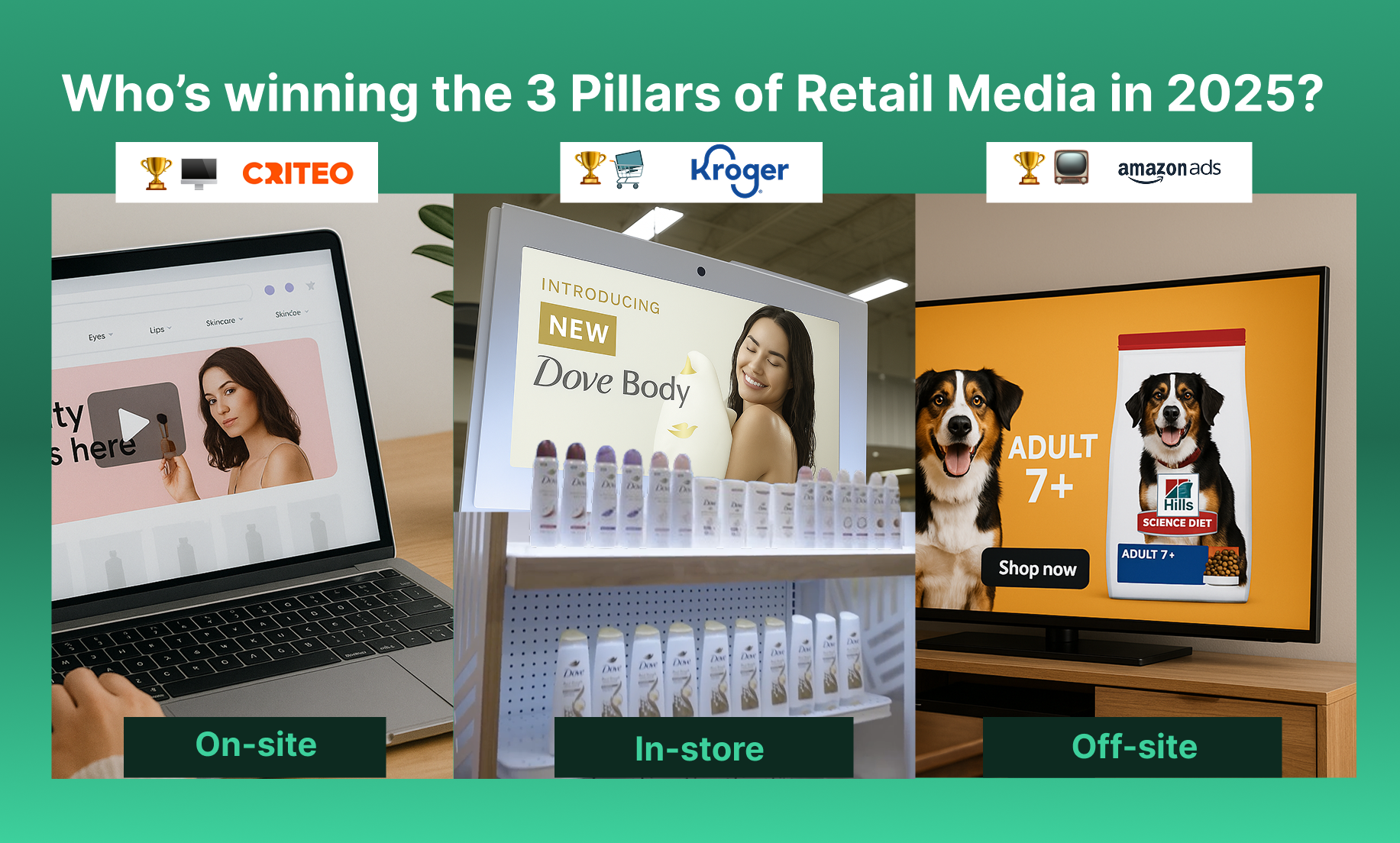

Everyone says Retail Media is more than product listing ads. But until this year, there wasn’t clear leadership to prove it. Mid-funnel tactics like programmatic display on mobile was a proxy for Offsite, while DOOH and CTV were seen as fodder for creative awards. Fears of inefficiency abounded...there were no clicks...and without true 1:1 targeting what happens if we reach an unknown shopper completely new to the brand!?
We’ve begun to relax a bit now that Retail Media seems to be tasked with saving all media. From our last two episodes and the news coming from Cannes, we’re seeing some new clarity when it comes to innovation to bring brand budgets under the retail media tent. Now that we’re at the midpoint for 2025, it’s time to name the winners of higher funnel activation for the three pillars of Retail Media: Onsite, In-store, and Offsite.
When I suggested that new display formats and on-site video was a big deal for retailers with Todd Sawicki he looked at me cross-eyed, because duh, onsite video for advertising is nothing new to the publishing world. But in Retail Media, many retailers didn't have enough scale to make display or video interesting, and there wasn't an understanding of what to do with it - especially since advertisers often asked to link away from the retailers site. As silly as it sounds it either went unsold or was left to a sponsorship model, and as a result the creative was just static.
I mentioned in our Costco episode that I was excited that someone finally took up Criteo on their butterfly ads that placed display creative alongside of product listing ads in the grid. Since then, Mark Williamson appeared on Criteo’s webinar saying that ‘video is very endemic to the Costco shopping experience’ and amplifies Costco’s ability to teach consumers ‘why you would want to buy that thing that you never knew you always wanted’.
What this meant to me is whether Sherry Smith wanted to take credit for it or not in our episode, Criteo is completing the unfinished business that Triad started in running Walmart’s On-site display ads 10+ years ago. After thoroughly winning at product listing ads, Criteo is now ready to innovate on display and video...and not in the way some creative formats ‘cheat’ by just animating SKU cards or zooming in on price points. Criteo’s roadmap, teased in the webinar, showed real progress moving out of its comfort zone and suggesting that brands use its new SKU-less “Standout” formats, to win the category, drive brand messaging and create awareness.
We’ve been waiting for someone to do a big push for in-store digital media, but to be fair this is an expensive proposition. Last year we got a glimpse of the idea with Walmart Connect's 'Time Well Spent' campaign in our episode with Trevor Sumner, but I haven’t heard much about the rollout since. This time, the push for bespoke yet scalable in-store digital signage is for real, and it’s no shock that America’s Grocer is making the investment and changing the fundamentals of store design. Our earlier episode into the history of Kroger’s loyalty program with Peter V.S. Bond of the CPG Guys made me think that Kroger might invest in e-ink digital shelf talkers to focus on scaling more single SKU promotions. Perhaps, as the WSJ reported this weekend, the very steep decline in coupons and promotions overall since the pandemic has made loyalty less of a priority for In-store innovation.
Instead what we see is Christine Foster from Kroger’s Precision Marketing team & 84.51˚ in partnership with Barrows deploying high-impact digital screens across entrances, endcaps, and aisles—showcasing ads that look and feel like display ads you’d see on a website or CTV. But screens aren’t enough. Kroger is pushing past just a simple CTV ad relationship with Roku that started in 2020. In a play to make the store an experiential canvas, Kroger is deepening their partnership with Roku by establishing their own studio to create video recipes content to put on these screens. Of course those recipe-type videos might get sliced up could find their way to other retail media touch-points. Instead, of using screens purely to automate price changes, they’re using them to build emotional connections, provide utility and really capture attention.
As Christine relates, the inertia still exists in Retail Media because it’s harder to tie upper funnel tactics to the lower funnel tactics that are taking credit for everything.
“Looking back at that partnership [with Roku for CTV campaigns at Kroger], there’s a proven track record of measurable results for exposed audiences and 3x higher spend vs. unexposed consumers… But the long-held assumption on retail media has been so focused on the lower funnel, so focused on those conversion moments, that no one was really figuring out how do you tie these upper funnel tactics to this lower funnel in a way that makes sense… that actually is about making sure you’re telling stories across every single touchpoint and building brands across the full funnel.” — Christine Foster, Kroger Precision Marketing
We haven’t had Amazon on the podcast yet, but I had started chatting with Jeffrey Cohen way back at CES so maybe we’ll get there soon. Jeffrey presented Amazon’s POV in his recap of their big announcements at Cannes where he said ‘we redefined what's possible when premium content meets commerce intelligence'. He's referring to two announcements, first Amazon's new partnership with Roku, the largest streaming platform in the US to reach 80 million households, and then Amazon's partnership with Disney’s DRAX.
Amazon is clearly making the case that they are winning the Off-site Retail Media game amidst much hype from everyone else who isn’t Amazon. Physical-first retailers have driven Retail Media through their JBPs and have had a hard time selling CTV because they have a trade / shopper marketing focus, and aren't in the conversation with between the brands and their agencies on developing higher funnel creative assets. Because Amazon lacks a physical retail DNA, the JBP was never their core muscle—so instead, they focused on what they do best: infrastructure, identity, and reach. As Danny Silverman put it to me recently:
“A Walmart or Albertsons JBP is all about help with the in-store experience. What’s on the racetrack, what’s in the center of store. Physical retailers are looking to vendors to have ideas about how to win with protein… none of this exists for Amazon.”
Where Amazon is strong is in both having logged-in consumers on their app, and after much work developing Fire TV and Prime Video, delivering server-side CTV ads with Amazon DSP and measuring them with their deterministic graph without having to rely on cookies. With their new partnerships, Amazon now has the tools to bring logged-in, first-party data-driven advertising into premium streaming environments.
Similar to what Christine Foster suggested is key to the next phase of bringing brand budgets into Retail Media, Amazon has the ability, without a large store presence to more simply tie higher and lower funnel ads to eCommerce performance. When Off-site includes both high and mid-funnel placements so that they can be measured with transaction data over longer lookbacks, the power of Off-site will become much clearer. And when Amazon leads, all other retailers take note.
Why This Matters: Retail media isn’t just expanding—it’s splitting into tiers of tactical leadership. Each player in this post is proving what’s possible when brand dollars meet platform ambition.